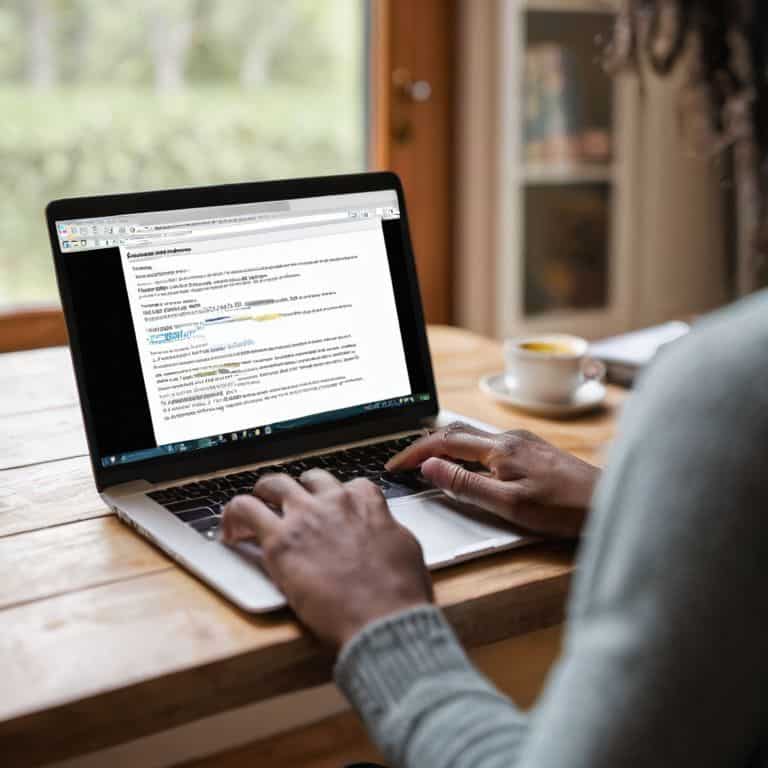I still remember the day my grandmother called me, frantic because she had clicked on a link in an email that seemed legitimate, but ended up compromising her entire computer. It was a harsh lesson for both of us – how to spot a phishing email is not just about being tech-savvy, it’s about being vigilant. The common myth that only the technologically illiterate fall for phishing scams is just that, a myth. In reality, phishing emails have become so sophisticated that even the most cautious among us can fall prey. The key is not to be afraid, but to be informed.
In this guide, I promise to walk you through the simple, yet effective steps to identify and avoid these sneaky emails. You’ll learn practical tips on how to spot a phishing email, from recognizing suspicious senders to being cautious of urgent requests. My goal is to empower you with the knowledge to protect yourself and your loved ones from these cyber threats. By the end of this article, you’ll be equipped with the skills to confidently navigate your inbox, knowing exactly what to look out for and how to respond when you encounter a phishing attempt.
Table of Contents
Guide Overview: What You'll Need

Total Time: 15 minutes
Estimated Cost: free
Difficulty Level: Easy
Tools Required
- Computer (with internet connection)
- Email Account (with access to inbox)
Supplies & Materials
- Knowledge of Phishing Tactics familiarity with common phishing email characteristics
- Critical Thinking ability to analyze email content
Step-by-Step Instructions
- 1. First, don’t panic when you see a suspicious email in your inbox. Instead, take a deep breath and let’s go through some simple steps to determine if it’s a phishing attempt. Think of it like checking the oil in your car – you want to make sure everything is running smoothly before you hit the road.
- 2. Next, inspect the sender’s email address carefully. Phishing emails often come from addresses that look similar to those used by legitimate companies, but with slight variations. For example, instead of an email from “[email protected],” the phishing email might come from “[email protected]” or “[email protected].” Make sure to check the address carefully, as it can be easy to overlook small changes.
- 3. Now, let’s talk about the subject line. Phishing emails often try to create a sense of urgency, with subject lines like “Your account has been compromised” or “You’ve won a prize – claim it now!” Be wary of emails that try to rush you into taking action, as this is often a tactic used by scammers. Instead, take your time and carefully evaluate the email before responding or clicking on any links.
- 4. The next step is to read the email body carefully. Phishing emails often contain spelling and grammar mistakes, which can be a dead giveaway. Additionally, be wary of emails that ask you to provide sensitive information, such as your password or credit card number. Legitimate companies will never ask you to provide this information via email, so if you see a request like this, it’s likely a phishing attempt.
- 5. It’s also important to check for suspicious links. Phishing emails often contain links that appear to be legitimate but actually lead to fake websites designed to steal your information. To check a link, hover your mouse over it without clicking, and look at the URL that appears in the bottom left corner of your browser. If the URL looks suspicious or doesn’t match the company’s website, it’s likely a phishing attempt.
- 6. Another step is to be cautious of attachments. Phishing emails often contain attachments that appear to be legitimate but actually contain malware. If you receive an email with an attachment from an unknown sender, it’s best to avoid opening it altogether. Instead, contact the company directly to verify the email and attachment.
- 7. Finally, trust your instincts. If an email looks or feels suspicious, it’s better to err on the side of caution. Don’t respond to the email or click on any links, and instead, contact the company directly to verify the email’s legitimacy. Remember, it’s always better to be safe than sorry when it comes to your online security.
Spotting Phishing Emails Made Easy

To make spotting phishing emails a breeze, let’s dive into some common phishing email examples. These can range from emails that claim you’ve won a prize to those that ask you to verify your account information. It’s essential to be aware of these tactics, so you can easily identify them in your inbox.
When it comes to email phishing attack techniques, the key is to stay vigilant. Phishing email red flags can include spelling and grammar mistakes, generic greetings, and a sense of urgency. If an email is trying to rush you into taking action, it’s likely a scam.
By adopting safe email practices for businesses, such as verifying sender information and being cautious with links and attachments, you can significantly reduce the risk of falling victim to phishing scams. Remember, it’s always better to err on the side of caution when it comes to your email security.
Common Red Flags to Watch Out
When reviewing emails, keep an eye out for common red flags. These include spelling and grammar mistakes, which are often a dead giveaway of a phishing email. Additionally, be wary of emails that create a sense of urgency, such as threatening to close your account if you don’t act immediately. Legitimate companies usually don’t use high-pressure tactics like this. Also, check the sender’s email address – if it’s not from the official company domain, it’s likely a phishing attempt.
Look out for generic greetings, such as “Dear customer” instead of addressing you by your actual name. Legitimate companies usually have your name on file and will use it. By being aware of these common red flags, you can significantly reduce the risk of falling victim to phishing emails.
Safe Practices for Businesses Online
To protect your business from phishing scams, it’s crucial to implement safe practices. This includes regularly updating software and security systems, as well as educating employees on how to identify phishing emails. Think of it like maintaining your car – you need to check the oil and tires regularly to prevent breakdowns. Similarly, by keeping your systems and staff up-to-date, you can prevent phishing attacks from causing damage.
By adopting these habits, you can significantly reduce the risk of a successful phishing attack. I recommend creating a simple checklist for your employees to follow, such as verifying sender addresses and being cautious with links and attachments. This way, you can ensure your business is protected and your employees are empowered to spot potential threats.
Don't Get Hooked: 5 Key Tips to Spot a Phishing Email
- Be cautious of emails with urgent or threatening messages, as they can be used to create a sense of panic and prompt you into taking action without thinking
- Verify the sender’s email address to ensure it’s genuine and not spoofed, just like checking the license plate on a car to make sure it matches the owner
- Watch out for spelling and grammar mistakes, as legitimate companies usually have professional email templates that are error-free, much like a well-maintained vehicle has no rusty parts
- Never click on suspicious links or download attachments from unfamiliar senders, as they can be malicious and harm your device, similar to how you wouldn’t put the wrong fuel in your car
- Always hover over links to check the URL before clicking, and make sure the website you’re being redirected to is secure (https) and has a legitimate domain name, just like checking your car’s navigation system for the correct route
Key Takeaways to Stay Safe from Phishing
Always verify the sender’s email address and look for spelling and grammar mistakes in the email, as these can be indicators of a phishing attempt
Be cautious of emails that create a sense of urgency or ask you to click on suspicious links, and never provide sensitive information via email unless you’re absolutely sure it’s legitimate
Regularly update your antivirus software, use strong passwords, and enable two-factor authentication to add extra layers of security against phishing attacks
Wisdom in a Nutshell
The key to spotting a phishing email is not to be a tech expert, but to be a cautious and curious observer of the digital world – think of it like checking your car’s dashboard for warning lights before a long drive.
David Fletcher
Stay Safe Online: A Final Word

As we wrap up this guide on how to spot a phishing email, let’s do a quick recap of the key red flags to watch out for. We’ve covered the importance of verifying sender addresses, being cautious with links and attachments, and keeping an eye out for spelling and grammar mistakes. By following these simple steps and staying vigilant, you can significantly reduce the risk of falling victim to phishing scams. Remember, it’s all about being proactive and taking the time to thoroughly inspect each email that lands in your inbox.
So, the next time you’re browsing through your emails, take a deep breath and remember that you’re in control. With your newfound knowledge, you can confidently navigate the online world, avoiding potential threats and keeping your personal data safe. By empowering yourself with this knowledge, you’re not only protecting yourself but also contributing to a safer online community. Keep in mind that staying safe online is an ongoing process, and it’s essential to stay informed and adapt to new threats as they emerge.
Frequently Asked Questions
What are some common phrases or words that phishing emails often use to trick me?
Don’t Panic! Phishing emails often use urgent phrases like “Your account will be closed” or “Verify your info now.” They might also claim you’ve won a prize or need to update your password. Be cautious with emails containing words like “immediately,” “warning,” or “expiration.” These are often tactics to create a sense of panic and prompt you into taking action without thinking.
How can I verify if an email is really from my bank or a legitimate company?
Don’t Panic! Verifying an email’s legitimacy is easier than you think. Check the sender’s email address – it should exactly match your bank’s or company’s official domain. Look for a personal greeting with your actual name, not a generic “customer.” Legitimate emails often include your account details or reference a recent conversation. If still unsure, contact the company directly using a phone number from their official website, not the email.
Are there any browser extensions or tools that can help automatically detect phishing emails?
Don’t Panic! Yes, there are browser extensions like uBlock Origin and tools such as Mailchimp’s phishing detector that can help automatically detect phishing emails, giving you an extra layer of security. Think of them as your car’s airbag – they’ve got your back in case something sneaky slips through.









